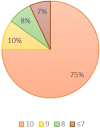Photobiomodulation for Preventive Therapy of Recurrent Herpes Labialis: A 2-Year In Vivo Randomized Controlled Study
- PMID: 36219750
- PMCID: PMC9603276
- DOI: 10.1089/photob.2022.0054
Photobiomodulation for Preventive Therapy of Recurrent Herpes Labialis: A 2-Year In Vivo Randomized Controlled Study
Abstract
Objective: The present study aimed to evaluate the effectiveness of the application of photobiomodulation therapy (PBMT) in the prevention of recurrent herpes labialis (RHL) through a randomized controlled clinical trial. Background data: RHL is a lifelong infection that effects patients' quality of life. In the literature PBMT has shown positive results preventing RHL, decreasing recurrences and severity of lesions. Despite the good results reported, there are still few controlled clinical studies published on the subject. Methods: For this study, 158 volunteers were recruited and were randomly divided into three study groups: Laser 1-1 J/point (L1J): n = 61, Laser 2-2 J/point (L2J): n = 50, and placebo-0 J/point: n = 47. The treatment consisted of a protocol of 15 sessions throughout 6 months and 2 years of follow-up posttreatment. Results: The results showed that L1J presented the most satisfactory results concerning the reduction of the number of lesions per year and less severity of recurrences in the long-term evaluation when compared with L2J. Both Laser Groups (L1J and L2J) were statistically more efficient than placebo in all aspects analyzed. All patients who received laser treatment (L1J and L2J) and presented recurrences had significant improvement in frequency and/or severity of lesions. No patient had side effects from treatment. Conclusions: PBMT can be effective in the reduction of the frequency of recurrences of RHL and in the severity of postirradiation lesions that may appear.
Keywords: herpes labialis; laser; photobiomodulation; prevention.
Conflict of interest statement
No competing financial interests exist.
Figures




References
-
- Spruance SL. The natural history of recurrent oral-facial herpes simplex virus infection. Semin Dermatol 1992;11(3):200–206. - PubMed
Publication types
MeSH terms
LinkOut - more resources
Full Text Sources
Medical

